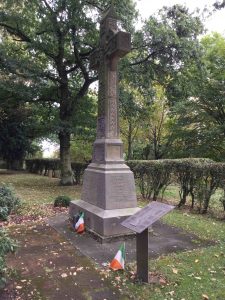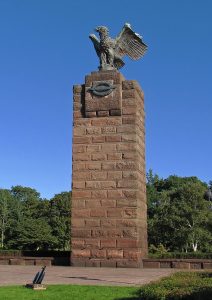On my recent visit to Ireland to attend the centenary commemorations of the sinking of RMS Leinster (discussed in the post below), I took the opportunity to travel through Germany to research a couple of aspects of the Irish involvement in the First World War. In doing so, I visited the Deutsches U-Boot Museum and archive at Cuxhaven on the North Sea coast to obtain information on the German submarine UB-123 that sank the Leinster and to view the U-Boat memorial at Möltenort near Heikendorf and the naval memorial at Laboe, both on the eastern shore of the Kiel inlet.
The Möltenort memorial commemorates those who died serving in U-Boats during the First and Second World Wars, along with all victims of submarine warfare. Names of fallen German submariners are displayed on 115 bronze plaques in an arched gallery. They include the crew of UB-123 who died on the return journey to Germany when their submarine struck a mine.
The Laboe memorial commemorates the German naval dead of both world wars as well as sailors of all nationalities who were lost at sea.
The other place I visited was Limburg an der Lahn, about 50 kms north-east of Frankfurt am Main. Outside of Limburg, which has a beautiful and well-maintained old town, is the site of the prisoner of war camp where Roger Casement unsuccessfully tried to induce Irish prisoners of war to join an Irish Brigade to fight on the German side in the war.Nothing remains of the camp near the village of Dietkirchen that once housed 12,000 prisoners (about 2300 of them Irish), but standing in the Kriegsgräberstätte (the war cemetery known locally as the Russian war cemetery because of the many Russian graves) is a three-metre-high sandstone Celtic cross that was erected in 1917 on the initiative of Father Thomas Crotty, an Irish Dominican, who was sent by the Vatican to administer to the spiritual needs of the Irish prisoners.
 The cross, whose construction was paid for by the Irish prisoners, is inscribed with the names of Irish soldiers who died in the camp. However, there are no headstones marking their graves. In the mid 1920s the remains of Commonwealth servicemen (including Irish) who had died all over Germany were removed to four permanent cemeteries. Those in Dietkirchen were reburied at Niederzwehren. In 2007 restoration work was undertaken and the cross reconsecrated.
The cross, whose construction was paid for by the Irish prisoners, is inscribed with the names of Irish soldiers who died in the camp. However, there are no headstones marking their graves. In the mid 1920s the remains of Commonwealth servicemen (including Irish) who had died all over Germany were removed to four permanent cemeteries. Those in Dietkirchen were reburied at Niederzwehren. In 2007 restoration work was undertaken and the cross reconsecrated.
Information concerning the erection and restoration of the cross and the story of the Irish prisoners at Limburg and Casement’s attempt to enlist them can be found in Ronan McGreevy, Wherever the Firing Line Extends: Ireland and the Western Front, History Press, Dublin, 2016, ch. 5. See also Frank Taaffe’s Eye on the Past blogs for 23 April 2014 and 3 November 2015 which provide further information on Fr Crotty and some of the Irish prisoners at Limburg.


